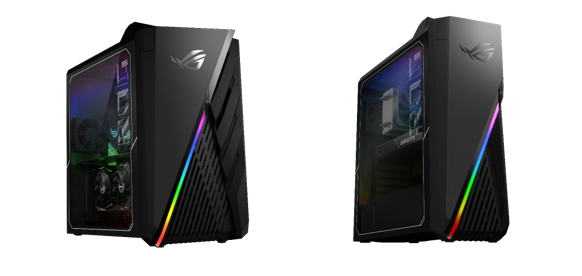Asus’ Latest eSports-Focused Strix Desktops Top Out With AMD Ryzen 3950X, Nvidia RTX 2080 Ti
In what seems to be a trend here at CES 2020, Asus’ latest Strix gaming desktops will ship in both AMD (GA35 and GA15) and Intel (GT35, GT15) flavors, with the AMD Ryzen 3000 models available sometime this quarter, while Intel variants (with 10th Generation Intel CPUs) coming “later in 2020," Asus said.
The GA35 and GT35 are the higher-end offerings, sporting up to an RTX 2080 Ti graphics card and CPUs on the AMD side ranging from the Ryzen 3 3700X, up to the 16-core, 32-thread Ryzen 9 3950X. The systems will sport Strix-branded motherboards and graphics cards, RGB lighting up front and inside and EMI-shielded glass side panels for protecting against electromagnetic interference.
Other key features of these gaming desktops include two front-panel USB 3.2 Gen 2 Type-C ports and two USB 3.2 Gen 1 Type-A ports, along with support for the company’s Keystone II tech. The latter is an NFC-enabled dongle designed for those who share their gaming rigs with others. The device lets you easily access system settings that are linked to your ROG ID. It can also be used to launch individual programs when plugged in, or unlock a hidden drive partition.
Storage is handled by NVMe SSDs up to 1TB, with some models also including a 2TB HDD. And the X570-F Gaming motherboard on the GA35 includes a second M.2 slot and two 3.5-inch drive bays for adding more storage later.
For those gamers who don’t need (or can’t afford) such extreme levels of performance, the GA15 (AMD) and GT15 will sport a slimmer chassis with similar looks as the larger models with up to RTX 2070 Super graphics, the 8-core Ryzen 7 3800X processor and up to 32GB of RAM (the larger GA/GT35 models support up to 64GB).
We’re still waiting on pricing, but Asus expects the AMD-based GA35 and GA15 to be available in the first quarter of 2019, while the GT35 and GT15 with 10th Gen Intel Core processors will arrive later in the year--likely not long after Intel launches its latest mainstream desktop CPUs.
Get Tom's Hardware's best news and in-depth reviews, straight to your inbox.
After a rough start with the Mattel Aquarius as a child, Matt built his first PC in the late 1990s and ventured into mild PC modding in the early 2000s. He’s spent the last 15 years covering emerging technology for Smithsonian, Popular Science, and Consumer Reports, while testing components and PCs for Computer Shopper, PCMag and Digital Trends.

